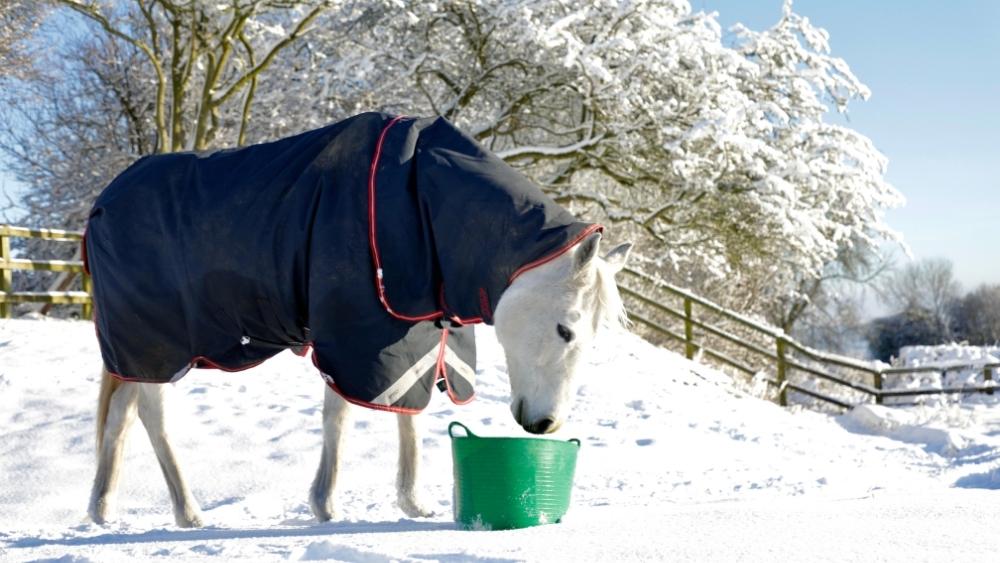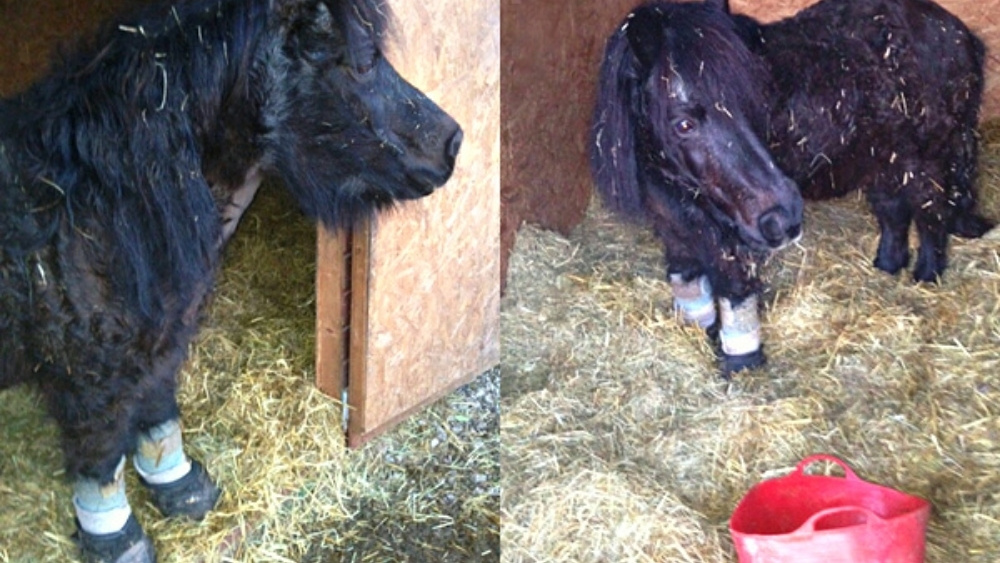- Mycotoxins and the Horse - April 1, 2023
- Winter Horse Feeding - February 3, 2022
- Feeding a Performance Horse - December 21, 2021
Many horses seem to struggle with laminitis during the winter months. Cold weather can cause winter laminitis in horses.
Should you protect a laminitic horse when the weather is cold? Discover how you can help your horse and avoid laminitis due to the cold.
Here in the UK, our winters are long and wet. We are blessed really not to have too many extremes but it can be relentlessly miserable and this seems to set the scene for some horses to have problems with cold-induced laminitis. Many people put these sensitivity issues down to the wet and that could be true but for some horses, it seems the cold might be to blame.
Most people associate spring and the flush of grass with the onset of laminitis season however many owners report problems in winter, particularly with horses who have a history of metabolic issues resulting from insulin resistance or Cushing’s (PPID).
If you have the Cushings well under control with pergolide, are monitoring ACTH levels regularly and are feeding a low sugar, low starch diet, then considering the cold as a possible trigger for hoof pain is useful.

Damage to the AVA shunts can result from laminitis
A couple of years ago we attended a series of lectures given by Professor Chris Pollitt (Queensland University – School of Veterinary Science) who described how he had identified damage to the laminae in horses without the apparent external symptoms of laminitis. This damage affected the vascular system in the hoof.
He discussed how AVA (arteriovenous anastomosis) shunts inside the hoof capsule change the direction of blood flow to aid in cooling or warming the extremities; Dr Pollitt’s video, “Horse Foot Studies” shows the fine blood supply of a rabbit’s ear and how it contains tiny shunts that prevent the bunny ears from freezing on very cold nights.
So in cold conditions, the shunts inside a horse’s hoof will allow increased blood flow and therefore maintain heat within the hoof. This is apparently one reason why horses are so good at living in so many different latitudes. However what he observed was that these shunts could become damaged, sometimes when horses had had quite small laminitis attacks which either went relatively unnoticed or had been presumed to have been recovered from.
We have observed quite a number of horses who exhibit problems when the temperature drops below a certain level for an extended period of time and we hypothesise that one of the reasons for this is that these AVA shunts have been damaged and are therefore not allowing adequate thermoregulation in the hoof capsule.
Obviously, it is important to rule out other causes and involve a vet in a thorough investigation but it is worth considering that a few simple steps to keep your horse’s legs warm might be a very real answer and a preventative course of action for reducing or eliminating these attacks.
The horses that demonstrate problems with the cold often have a history of prior laminitis problems or at least a suspicion of insulin resistance/equine metabolic syndrome. Some even have a history of winter laminitis that strikes at the same time every year and is resistant to all efforts at treatment until one day in early Spring it suddenly goes away.
Eleanor Kellon VMD has worked with laminitic horses closely for over 10 years and she suggests that even when there have not been previous obvious laminitic episodes the cold can be a significant problem for some horses and their hooves. She writes about levels of cortisol and insulin:
“high levels of cortisol in Cushing’s horses and insulin resistance in metabolic syndrome horses may put these animals at risk of cold induced pain. Cortisol has been documented to dramatically increase hoof responses to vasoconstrictors, circulating chemicals that make vessels contract. Insulin is normally a vasodilator, an agent that makes blood vessels dilate. With insulin resistance, this response may be blocked.”
— Eleanor Kellon VMD
Health of the AVA shunts affects blood supply in the equine hoof
So you may have a horse that has not shown obvious outward signs of laminitis but it might have damage to the AVA shunts which then affects the efficiency of the blood supply in the hoof which can lead to insufficient circulation during cold weather.
Add high levels of insulin and cortisol due to metabolic imbalance and you have a recipe for more vasoconstriction and even poorer circulation into the hoof capsule. So the question is are these horses, which go sensitive on their feet in the winter, possibly experiencing problems due to a vascular network that has been damaged and now cannot respond in a ‘normal’ way to temperature challenges in the environment?
Again Dr Kellon’s vast experience in this area would support this idea:
“Evidence supporting this theory was obtained by an owner of a horse with a history of repeated bouts of winter laminitis. She took her horse to her veterinarian’s clinic for thermographic examination. Thermography measures the surface temperature of the body. The horse was placed in a room with an air temperature of 40° Fahrenheit/4.4° centigrade. After removing leg wraps and lined hoof boots, the temperature of the front feet, which had been repeatedly affected by laminitis in the past, dropped considerably lower than the temperature of the hind feet.”
— Eleanor Kellon VMD
Researchers have reported that in other species adaption to cold weather causes reduced metabolism and an element of insulin resistance (think hibernation here). This means that insulin levels can become highly variable in cold weather so an endocrine challenged horse can quite literally be tipped over the edge. For a healthy normally functioning horse none of this is a problem but perhaps if your AVA shunts and vascular hoof system are not optimal this is when we see increased hoof sensitivity and possibly full-blown laminitis.

So what can YOU do to help your horse and prevent or control cold weather induced laminitis?
- Keep an eye on the temperature, if you need gloves then, if you have one of these cold affected horses, this can be a useful guide as to whether they may be affected by cold induced lamintis. You will probably need to bring your horse under cover or provide adequate shelter but where possible allow the room to walk about.
- Make sure you are feeding a low sugar, low starch, forage focussed mineral balanced diet.
- Wrapping the legs right down to the coronary bands in thermotex wraps or gamgee and stable bandages can be effective. Travelling boots over the top of this can afford even greater protection.
- Avoid long periods of time standing on concrete. Concrete saps the heat from feet, think of how it feels when you stand on concrete for a period of time in wellies. Covering the concrete with rubber mats to insulate the concrete surface is wise.
- Deep bedding (shavings) where the horse is not reliant on standing on a cold surface can also help. In this instance horses can often be seen digging their toes into the bedding to angle their feet. This may help improve circulation by taking pressure off the rear of the hoof capsule as well as creating an insulating layer around the hoof capsule. Deep littering the bedding for a time to generate heat may also be something to think about whilst of course keeping an eye on hygiene.
- Some horses need the actual hoof capsule insulating and here you have to get creative with a hoof boot lined with an insulating material.
If the above is not sufficient then an extra course of action is to use nutraceuticals to lower cortisol and help metabolism. For extreme cases then keeping the extremities warm and feeding an adaptogen and AAKG can be highly successful.
Adaptogens are herbs that can regulate cortisol and the stress responses which create fluctuating cortisol levels. Cortisol contributes to insulin spikes due to the fact that is the ‘flight or fight hormone’.
Jiaogulan is a good adaptogenic herb to use because it encourages vascular nitric oxide production which helps maintain circulation and support blood flow to the hooves.
Adaptogenic herbs have been shown by members of the ECIR Yahoo Group to be extremely successful in managing an environment where the body is able to resist cold weather-induced hoof sensitivity. The APF, adaptogenic products developed by Auburn Labs are also useful.
AAKG (L-arginine-alpha-ketoglutarate) is a form of arginine which is also useful support. Arginine is an amino acid that the body can use to make nitric oxide. Nitric oxide has been shown in research to regulate blood pressure by dilating arteries and reducing inflammation. It can be given twice daily, sometimes 3 to 4 times daily to support blood levels in the hoof.
Be sure to take a look at our other interesting injury and disease articles here.
Sign up to receive our latest eBooks and podcasts directly to your inbox!
Last Updated on February 22, 2022 by Forageplus Team


